-
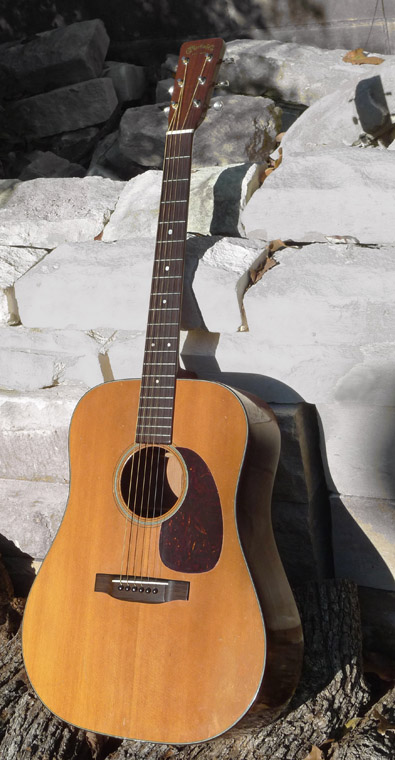 This is another great mid-fifties dread in unbelievable condition. It’s totally crack-free (also, not even a “pick guard” crack). Was acquired in 100% original condition: bridge, saddle, bridge pins, tuners, everything. Just had a neck set– resulting in great action, and tone/projection. With new condition Martin hard shell case.
This is another great mid-fifties dread in unbelievable condition. It’s totally crack-free (also, not even a “pick guard” crack). Was acquired in 100% original condition: bridge, saddle, bridge pins, tuners, everything. Just had a neck set– resulting in great action, and tone/projection. With new condition Martin hard shell case. -
Out of stock
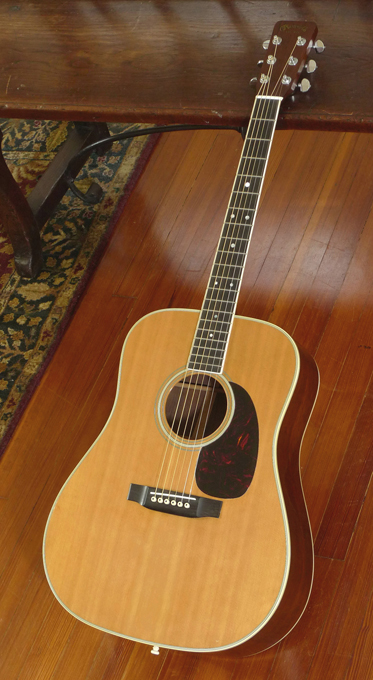 If there is a mid-60’s Brazilian Rosewood D-35 in better original condition out there than this one– it would have to be new. About as close to mint as you can get, this guitar shows little wear. And the Brazilian on back and sides– wonderful specimens, not the “figured” stuff you see on many later 60’s Martins. Not a crack, or hint of crack, anywhere (no, not even the typical “pickguard” crack). Original bridge, tuners, etc. Original frets show almost no wear. All original finish everywhere–and note that the finish does not have any of that “crazing” you often see on the original finishes of mid-60’s Martins. It has never had strap lugs attached. It has the more desirable original tortoise pickguard (Martin changed to black pickguards, later in 1967). Original small maple bridge plate, in original condition. The tone of this guitar, is wonderful. Ringing trebles like the very best brazilian Martin dread’s. And a bass response that shows why Martin brought out this model, in 1965, as an even higher-end model (and with lighter bracing) than the D-28. There are few tiny dings near the edge of the lower bout, on top (too small to photograph well). But a D-35 in better condition than this one would have to be off the factory floor. Action is perfect. Neck straight. Ready to play.
If there is a mid-60’s Brazilian Rosewood D-35 in better original condition out there than this one– it would have to be new. About as close to mint as you can get, this guitar shows little wear. And the Brazilian on back and sides– wonderful specimens, not the “figured” stuff you see on many later 60’s Martins. Not a crack, or hint of crack, anywhere (no, not even the typical “pickguard” crack). Original bridge, tuners, etc. Original frets show almost no wear. All original finish everywhere–and note that the finish does not have any of that “crazing” you often see on the original finishes of mid-60’s Martins. It has never had strap lugs attached. It has the more desirable original tortoise pickguard (Martin changed to black pickguards, later in 1967). Original small maple bridge plate, in original condition. The tone of this guitar, is wonderful. Ringing trebles like the very best brazilian Martin dread’s. And a bass response that shows why Martin brought out this model, in 1965, as an even higher-end model (and with lighter bracing) than the D-28. There are few tiny dings near the edge of the lower bout, on top (too small to photograph well). But a D-35 in better condition than this one would have to be off the factory floor. Action is perfect. Neck straight. Ready to play. -
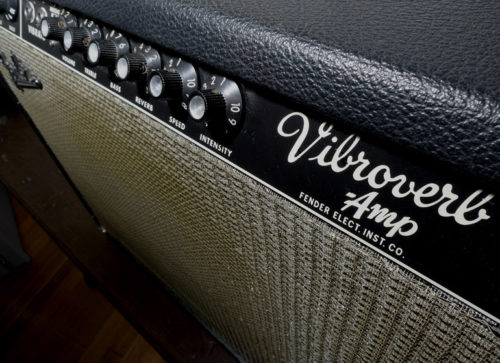 The blackface Vibroverb may be the most sought after Fender amp of all time. Stevie Ray Vaughan is famous for using them. The Vibroverb started as a 2x10 combo with reverb in '63. Then in late '63, Fender decided to switch to a 1x15. This amp has incredible tone. One must hear a black face circuit through an open cabinet JBL 15" speaker to understand the sound. It sounds big and can fill the hall, but it can work as a mid size amp perfect for gigs. This amp is versatile, since the JBL D130 can carry the treble of a telecaster or strat while still having a strong bottom end. Most other amps are either good on highs (Vibrolux, Princeton, Champ), good on lows (Twin, Showman), midrangy (Deluxe, and most new amps) or too big (Marshall double stack). The great Vibroverb is superior to them all. This 1964 Blackface Vibroverb has the original JBL speaker, and the original transformer. The amp also comes with its original footswitch. The only thing done to the amp has been replaced tubes, and the caps. The power cord has been replaced with a grounded three-prong cord.
The blackface Vibroverb may be the most sought after Fender amp of all time. Stevie Ray Vaughan is famous for using them. The Vibroverb started as a 2x10 combo with reverb in '63. Then in late '63, Fender decided to switch to a 1x15. This amp has incredible tone. One must hear a black face circuit through an open cabinet JBL 15" speaker to understand the sound. It sounds big and can fill the hall, but it can work as a mid size amp perfect for gigs. This amp is versatile, since the JBL D130 can carry the treble of a telecaster or strat while still having a strong bottom end. Most other amps are either good on highs (Vibrolux, Princeton, Champ), good on lows (Twin, Showman), midrangy (Deluxe, and most new amps) or too big (Marshall double stack). The great Vibroverb is superior to them all. This 1964 Blackface Vibroverb has the original JBL speaker, and the original transformer. The amp also comes with its original footswitch. The only thing done to the amp has been replaced tubes, and the caps. The power cord has been replaced with a grounded three-prong cord. -
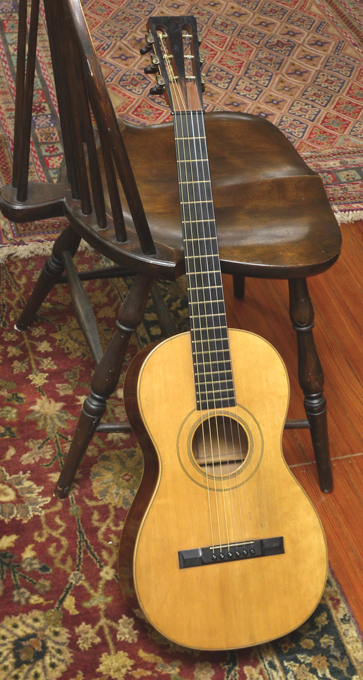 Circa 1860 parlor guitar style 1 built by well known luthier, James Ashborn of Wolcottville, CT, for William hall & son music store. Brazilian rosewood back and sides; Adirondack top; maple binding. This guitar is crack free save for a couple of minor finish cracks on back, and is 100% original, including all original finish, and down to original nut, original bridge (and saddle) that has never been off the guitar, and original bridge pins. From a just-published article in Vintage Guitar magazine: “Ashborn's design for the guitar was quite innovative for the early 19th century. Instead of making guitars fashioned after the typical parlor-style guitars, he made them in the Spanish style, by taking interior bracing cues from the Spanish while retaining the body of the English guitars. This included a fan brace pattern rather than the more common ladder pattern Ashborn guitars have a very complex dovetail V joint for attaching the head to the neck. The headstock was cut in roughly five steps, using some kind of tracing router, as suggested by the chatter marks on the inside ears of the pegbox. In addition to the complex head design, Ashborn made his own tuning machines in-house. They're made of brass, very much like contemporary machines, with worm gears, cog gears, and rollers. … Ashborn's shop was extremely advanced for its time, having a great deal of know-how and technology. Ashborn understood the need to have the technology as well as the skill, but more importantly he discovered a new way of making high-quality instruments that were affordable. He was able to create a factory environment where workers did what they were good at and, with practice, became very fast and consistent. With a new level of consistency in mass production, he created the path followed by other companies such as Martin, Gibson, and Taylor. Using designs ahead of his time, he was able to bring the sound and change to people who otherwise never would have been able to acquire an instrument of this quality.” This beautiful all-original and crack-free Ashborn guitar is one of the best-preserved examples in existence.
Circa 1860 parlor guitar style 1 built by well known luthier, James Ashborn of Wolcottville, CT, for William hall & son music store. Brazilian rosewood back and sides; Adirondack top; maple binding. This guitar is crack free save for a couple of minor finish cracks on back, and is 100% original, including all original finish, and down to original nut, original bridge (and saddle) that has never been off the guitar, and original bridge pins. From a just-published article in Vintage Guitar magazine: “Ashborn's design for the guitar was quite innovative for the early 19th century. Instead of making guitars fashioned after the typical parlor-style guitars, he made them in the Spanish style, by taking interior bracing cues from the Spanish while retaining the body of the English guitars. This included a fan brace pattern rather than the more common ladder pattern Ashborn guitars have a very complex dovetail V joint for attaching the head to the neck. The headstock was cut in roughly five steps, using some kind of tracing router, as suggested by the chatter marks on the inside ears of the pegbox. In addition to the complex head design, Ashborn made his own tuning machines in-house. They're made of brass, very much like contemporary machines, with worm gears, cog gears, and rollers. … Ashborn's shop was extremely advanced for its time, having a great deal of know-how and technology. Ashborn understood the need to have the technology as well as the skill, but more importantly he discovered a new way of making high-quality instruments that were affordable. He was able to create a factory environment where workers did what they were good at and, with practice, became very fast and consistent. With a new level of consistency in mass production, he created the path followed by other companies such as Martin, Gibson, and Taylor. Using designs ahead of his time, he was able to bring the sound and change to people who otherwise never would have been able to acquire an instrument of this quality.” This beautiful all-original and crack-free Ashborn guitar is one of the best-preserved examples in existence. -
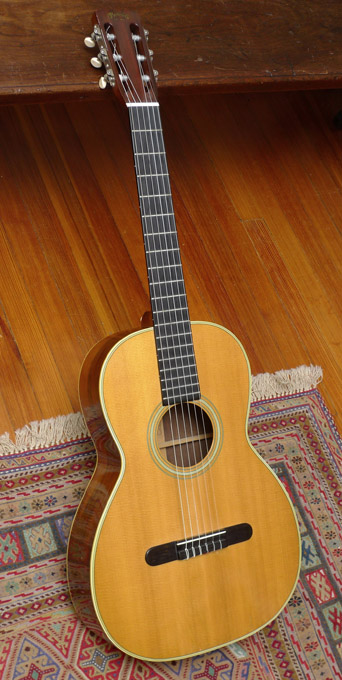 Another wonderful instrument with top grade Brazilian Rosewood back and sides. The Brazilian rosewood on this in instrument is more figured on the sides, and the back shows wonderful bookmatched figuring. This is an all-original guitar. There are no cracks that go through the wood. There are several finish/superficial cracks in the finish, one on the top near the bottom/endpin area, and one on the back. And a bit of crazing in the top finish. Set-up and playability is great. Wonderful full tonal range up and down the fretboard.
Another wonderful instrument with top grade Brazilian Rosewood back and sides. The Brazilian rosewood on this in instrument is more figured on the sides, and the back shows wonderful bookmatched figuring. This is an all-original guitar. There are no cracks that go through the wood. There are several finish/superficial cracks in the finish, one on the top near the bottom/endpin area, and one on the back. And a bit of crazing in the top finish. Set-up and playability is great. Wonderful full tonal range up and down the fretboard. -
Out of stock
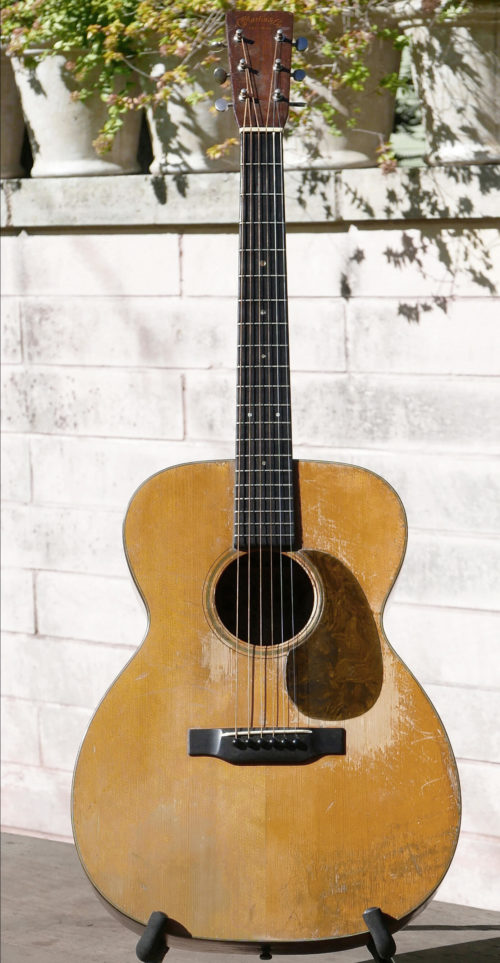 Impossible to mistake this guitar for a “1937 Authentic” or some such “recreation”. This 000-18 left the Martin factory in Nazareth, in 1937, indeed. And it’s been well-played since. More importantly, the tone is stellar– all you would expect from this style, this year, and more. Its bass response is similar to the best prewar D-18s. And it has the unmistakable string separation that only prewar Martins have. This instrument was in the family of its original owner until we obtained it. The original owner was Leroy Jenkins, a blind country artist in the 1950’s, in Texas, on the Dude label.
Impossible to mistake this guitar for a “1937 Authentic” or some such “recreation”. This 000-18 left the Martin factory in Nazareth, in 1937, indeed. And it’s been well-played since. More importantly, the tone is stellar– all you would expect from this style, this year, and more. Its bass response is similar to the best prewar D-18s. And it has the unmistakable string separation that only prewar Martins have. This instrument was in the family of its original owner until we obtained it. The original owner was Leroy Jenkins, a blind country artist in the 1950’s, in Texas, on the Dude label. -
Out of stock
 1957 Martin D-18 Guitar with Original Red Spruce Top Read the full description below. If you're interested in this guitar, please call 512.922.8596 or contact us here.
1957 Martin D-18 Guitar with Original Red Spruce Top Read the full description below. If you're interested in this guitar, please call 512.922.8596 or contact us here. -
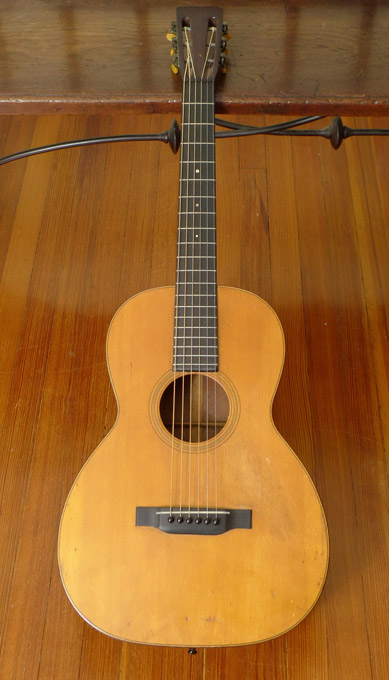 A great sounding 00-18, from the era when 18’s were light as a feather and have the resonance that result in singular tone– and this one from the time when Martin had just moved away from the pyramid bridge and to the belly bridge.
A great sounding 00-18, from the era when 18’s were light as a feather and have the resonance that result in singular tone– and this one from the time when Martin had just moved away from the pyramid bridge and to the belly bridge.- Original finish (with a bit of overspray, only on the area below the soundhole (typical light overspray where there was pick wear)
- Has just had neck set, here, perfect job
- Has just been refret, with period correct Bar frets obtained from TJ Thompson
- New, exact duplicate bridge made (it had its original belly bridge, but it had a crack and we preferred to replace the bridge with a perfect reproduction ebony belly bridge. New bridge, is on exact, correct footprint of original bridge
- the top of the guitar is crack-free
- the back of the guitar is crack-free
- Repaired side cracks, on both treble and bass sides
-
 The instrument features the original ebony bridge (full height), original tuners, original ivory saddle and nut, original maple bridge plate. Ebony fretboard. Bar frets. Thin, Soft-V neck. Finish is original. There is some overspray on the top, which is confined mainly to below the soundhole (over about the same size area, as what a pickguard would cover–but it never had a pickguard), and a bit below the bridge, and very very light on other areas of the top. Apparently a previous owner wanted to address the pick/finger wear and a repaired crack below the bridge. It's generally unobtrusive, no effect on the color of the top, and not noticeable from a few feet. Also, some light overspray on back and sides. As overspray goes, it has minimal effect on the appearance. Neck, and head have no overspray at all. There is one crack on the instrument from the bridge to the bottom of the guitar, but it's well repaired (it's about a half-inch from the center seam, below the bridge). Also about a 2 1/2 inch shallow crack/finish crack near where the fretboard meets the top (about 1/8 inch from the fretboard), on low-E side (does not go through–It is not visible on underside of top). There is a small indentation on the side rosewood (about one inch in area, on the side/lower, stable.) 1-7/8 inch nut. Action is 3/32 inch high E string/12th fret. 4/32 low E string… just right to get that full, cascading Brazilian tone from this fine 0-21.
The instrument features the original ebony bridge (full height), original tuners, original ivory saddle and nut, original maple bridge plate. Ebony fretboard. Bar frets. Thin, Soft-V neck. Finish is original. There is some overspray on the top, which is confined mainly to below the soundhole (over about the same size area, as what a pickguard would cover–but it never had a pickguard), and a bit below the bridge, and very very light on other areas of the top. Apparently a previous owner wanted to address the pick/finger wear and a repaired crack below the bridge. It's generally unobtrusive, no effect on the color of the top, and not noticeable from a few feet. Also, some light overspray on back and sides. As overspray goes, it has minimal effect on the appearance. Neck, and head have no overspray at all. There is one crack on the instrument from the bridge to the bottom of the guitar, but it's well repaired (it's about a half-inch from the center seam, below the bridge). Also about a 2 1/2 inch shallow crack/finish crack near where the fretboard meets the top (about 1/8 inch from the fretboard), on low-E side (does not go through–It is not visible on underside of top). There is a small indentation on the side rosewood (about one inch in area, on the side/lower, stable.) 1-7/8 inch nut. Action is 3/32 inch high E string/12th fret. 4/32 low E string… just right to get that full, cascading Brazilian tone from this fine 0-21. -
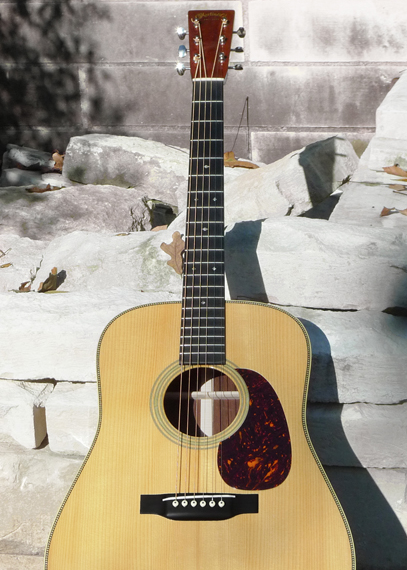 Martin has refined their “Authentic” series 1930’s recreations. When the first D-28A came out a about 5 years ago, it was Brazilian rosewood, with a price tag north of $20K. So when Martin decided to produce a Madagascar rosewood version, it was very welcome. In fact Martin learned from the earlier “Authentic” models and this guitar, one of the very first D-28 Authentics’s made with Madagascar rosewood, is a best of the breed– a recreation of the original 1937 D-28 model but now offered with Madagascar rosewood back and sides. And this instrument has a particularly good set of Madagascar.
Martin has refined their “Authentic” series 1930’s recreations. When the first D-28A came out a about 5 years ago, it was Brazilian rosewood, with a price tag north of $20K. So when Martin decided to produce a Madagascar rosewood version, it was very welcome. In fact Martin learned from the earlier “Authentic” models and this guitar, one of the very first D-28 Authentics’s made with Madagascar rosewood, is a best of the breed– a recreation of the original 1937 D-28 model but now offered with Madagascar rosewood back and sides. And this instrument has a particularly good set of Madagascar.- It’s in virtually unplayed, mint condition.
- Forward shifted hand-scalloped X-bracing
- Fingerboard Width At Nut: 1 3/4''
- Mahogany Blocks/Dovetail Neck Joint - Hide Glue
- Top: Solid Adirondack Spruce
- Top Braces: Solid Adirondack Spruce 5/16''
- Back Material: Solid Madagascar Rosewood
- Back Purfling: 28 Style Zig-Zag (Authentic)
- Side Material: Solid Madagascar Rosewood
- Neck Shape: Authentic 1937 Barrel & Heel
- Scale Length: 25.4''
- Bridge String Spacing: 2-5/16''
- Saddle: 16'' Radius/Long Bone
-
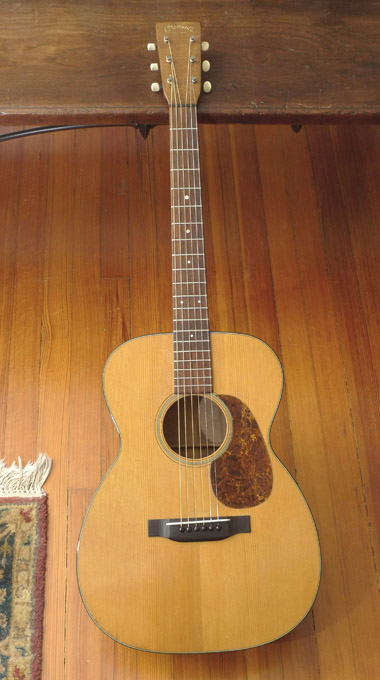 This is a prime example of why the pre-war, scalloped brace Martins made in 1943 in particular are the best sounding Martins ever: the ebony truss rod in the neck (instead of a metal truss rod– due to wartime metal rationing), the even more finely scalloped tone bars, and lack of metal tuner post bushings, all contribute to the lightness of build, and the robust tone, resonance and sustain you won’t find on any other Martin (not even the mid-30’s Martins). This guitar, seemingly light as a feather, plays like a dream, and is particularly resonant, and wonderful, for fingerpicking. (Martins from this year, often have a thinner finish, as does this one, which also contributes to its almost Shaker-like simplicity and beauty.) All original finish still in great shape. It has just had a new, Brazilian rosewood bridge made (from 100 year old, old-growth Brazilian rosewood, to the exact shape and footprint of the original which had a crack and was better replaced) by Tony Nobles (original bridge will ship, in the case). The bridge is hide-glued on, naturally. Aside from the typical B-string area “pickguard crack”, now well repaired and a non-issue, the top of the guitar is crack free. There is one well-repaired crack on the back. There was an old input jack right below the end pin, now filled expertly by Nobles (but no evidence of any pickups etc inside the guitar).
This is a prime example of why the pre-war, scalloped brace Martins made in 1943 in particular are the best sounding Martins ever: the ebony truss rod in the neck (instead of a metal truss rod– due to wartime metal rationing), the even more finely scalloped tone bars, and lack of metal tuner post bushings, all contribute to the lightness of build, and the robust tone, resonance and sustain you won’t find on any other Martin (not even the mid-30’s Martins). This guitar, seemingly light as a feather, plays like a dream, and is particularly resonant, and wonderful, for fingerpicking. (Martins from this year, often have a thinner finish, as does this one, which also contributes to its almost Shaker-like simplicity and beauty.) All original finish still in great shape. It has just had a new, Brazilian rosewood bridge made (from 100 year old, old-growth Brazilian rosewood, to the exact shape and footprint of the original which had a crack and was better replaced) by Tony Nobles (original bridge will ship, in the case). The bridge is hide-glued on, naturally. Aside from the typical B-string area “pickguard crack”, now well repaired and a non-issue, the top of the guitar is crack free. There is one well-repaired crack on the back. There was an old input jack right below the end pin, now filled expertly by Nobles (but no evidence of any pickups etc inside the guitar).- Original bridge plate, in fine condition. Original Frets.
- Original tuners (it looks like at one point there were other tuners on the guitar… with a few old screw holes filled.)
- Has never had strap lug attached to heel
- Top shows no “bellying”. Natural shape and slight arch is textbook perfect.
-
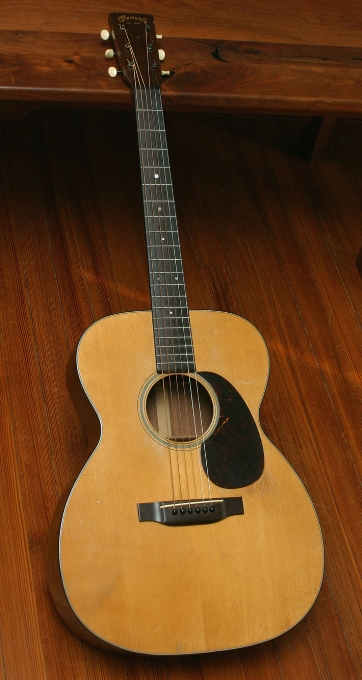 A rare, 100% original pre-war Martin. Not a crack anywhere. And though it of course has the 1-11/16 inch nut, it plays remarkably like the wider nut mid-30's 000-18's due to the generous (original) string spacing at the nut. Original finish. Neck has never been re-set. Original Ebony nut, ivory saddle, full height original bridge. Original tuners. Original plastic tuner buttons in great condition (no shrinkage). Lack of tuner ferrels of course (because of war-time metal shortages). Brazilian rosewood bridge, fingerboard, and peghead veneer. Scalloped braces. Original bridge plate. Frets show minor/normal wear. It shows light/normal pick wear around the soundhole (nothing anywhere near down to bare wood). Other minor superficial scratches on back, and sides. Bass tone and volume is impressive-the characteristic of war-time "pre-war" Martins, that featured more deeply scalloped braces. Many believe these more deeply scalloped braces found only in these years give them better tone than the mid-30s Martins. It does need a standard neck set. It's not egregiously out of set, action is a bit high at 12th fret. But due the originality of the instrument, original ivory saddle still hide glued-in, etc., we believe the buyer would want to set the neck to their liking. (We would be happy to set the neck for the new owner if desired, at no additional charge, after purchase.) The tone: gold standard pre-war 000-18. Loud, dark, crisp, and clear.
A rare, 100% original pre-war Martin. Not a crack anywhere. And though it of course has the 1-11/16 inch nut, it plays remarkably like the wider nut mid-30's 000-18's due to the generous (original) string spacing at the nut. Original finish. Neck has never been re-set. Original Ebony nut, ivory saddle, full height original bridge. Original tuners. Original plastic tuner buttons in great condition (no shrinkage). Lack of tuner ferrels of course (because of war-time metal shortages). Brazilian rosewood bridge, fingerboard, and peghead veneer. Scalloped braces. Original bridge plate. Frets show minor/normal wear. It shows light/normal pick wear around the soundhole (nothing anywhere near down to bare wood). Other minor superficial scratches on back, and sides. Bass tone and volume is impressive-the characteristic of war-time "pre-war" Martins, that featured more deeply scalloped braces. Many believe these more deeply scalloped braces found only in these years give them better tone than the mid-30s Martins. It does need a standard neck set. It's not egregiously out of set, action is a bit high at 12th fret. But due the originality of the instrument, original ivory saddle still hide glued-in, etc., we believe the buyer would want to set the neck to their liking. (We would be happy to set the neck for the new owner if desired, at no additional charge, after purchase.) The tone: gold standard pre-war 000-18. Loud, dark, crisp, and clear. -
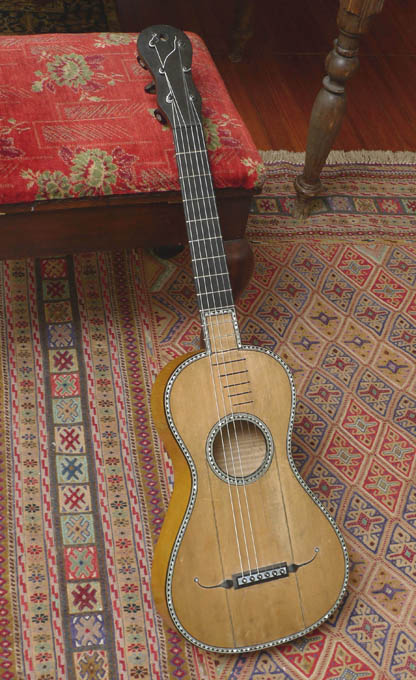 This fine and early example of the French guitar was made in Mirecourt, France, around 1800 to 1810. And sold through the famous Parisian dealer Koliker. It is a rare early example, as indicated by its rectangular bridge that does not have a separate saddle, but uses the top edge of the ebony rectangle as the saddle (this feature places it circa 1800, not like the more common 1820-1840 French guitars that have a more modern style bridge including a regular saddle). But for all its rarity, and exoticism to modern eyes, the most salient feature of this guitar is that it plays wonderfully. This is no museum piece to hang on a wall or shelf. This guitar is to play and enjoy. It plays beautifully, with all frets in tune. With no buzzing... I have had guitars from the 1960’s that do not play as well, in tune, and sound as well as this one. Even the action is perfect. The guitar has a wonderful tone, with a sweetness and brightness from the maple, and full bass response.
This fine and early example of the French guitar was made in Mirecourt, France, around 1800 to 1810. And sold through the famous Parisian dealer Koliker. It is a rare early example, as indicated by its rectangular bridge that does not have a separate saddle, but uses the top edge of the ebony rectangle as the saddle (this feature places it circa 1800, not like the more common 1820-1840 French guitars that have a more modern style bridge including a regular saddle). But for all its rarity, and exoticism to modern eyes, the most salient feature of this guitar is that it plays wonderfully. This is no museum piece to hang on a wall or shelf. This guitar is to play and enjoy. It plays beautifully, with all frets in tune. With no buzzing... I have had guitars from the 1960’s that do not play as well, in tune, and sound as well as this one. Even the action is perfect. The guitar has a wonderful tone, with a sweetness and brightness from the maple, and full bass response.- All original finish on the guitar
- Flamed solid Maple back and sides
- Spruce top, with no finish on the spruce… this is a characteristic of guitars from this time and place. While the back and sides of the guitar were French polished, the spruce top was left as natural wood, with no finish.
- One of the friction pegs is a modern replacement
- The two dark splices on the soundboard are later, but still 19th century, restorations, done as decorative flourishes.
- Scale length: 64.3 cm
- Length of body: 43.3 cm
- Koliker, Luthier Rue Croix-des-Petits Champs No. 24 A. Paris
-
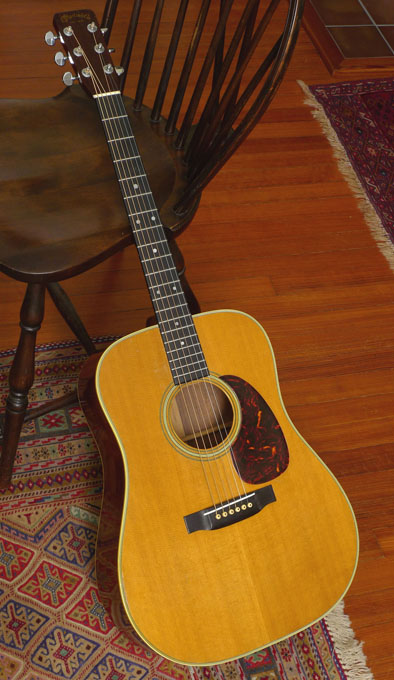 This Brazilian Rosewood D-28 dreadnaught from one of Martin’s finest eras, is special. Its structural integrity, and originality, are rare. And it’s one of the last Martin D-28’s made when Martin still used hide glue for guitar construction. This is a one-owner guitar, still in its original case. When we acquired it, it had not been played for years. Its original bridge, had a split in it, and had come loose from the top. Thus, it sat unplayed in its case for years. But all the wood beneath the bridge was pristine, perfect. So John Allison just made and installed a new exact reproduction bridge, from dark African ebony. It’s perfect, using the exact footprint of the original. The new bridge was attached with hide glue. And we used the original bridge pins.
This Brazilian Rosewood D-28 dreadnaught from one of Martin’s finest eras, is special. Its structural integrity, and originality, are rare. And it’s one of the last Martin D-28’s made when Martin still used hide glue for guitar construction. This is a one-owner guitar, still in its original case. When we acquired it, it had not been played for years. Its original bridge, had a split in it, and had come loose from the top. Thus, it sat unplayed in its case for years. But all the wood beneath the bridge was pristine, perfect. So John Allison just made and installed a new exact reproduction bridge, from dark African ebony. It’s perfect, using the exact footprint of the original. The new bridge was attached with hide glue. And we used the original bridge pins.- Guitar is 100% crack-free (no, not even a pickguard crack)
- 100% original finish, everywhere. No overspray or finish alterations of any kind. Minor dings and some minor pickwear around the soundhole.
- Has never had a strap lug attached
- Perfect condition maple bridge plate
- Original frets are in great condition
- Action is great, with just the right amount of saddle, and neck angle is perfect
-
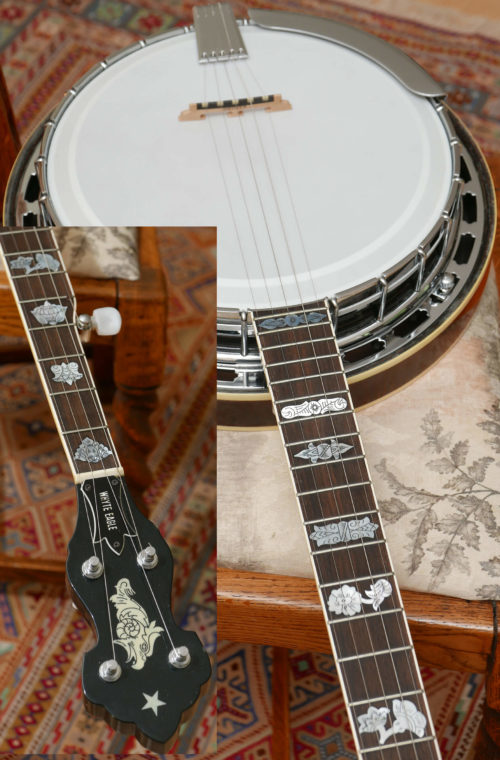 Early 1970s, but in remarkably original condition. And this instrument is from the first, early production– so it has the maple 3-ply rim. This should not be compared to later production Whyte Eagles– this is a very rare early one with unique features, and great tone. This banjo design is based on: • neck/head/inlays: based on the high end Fairbanks Whyte Ladye of the early 20th century– one of the most beautiful designs in banjo history • the pot assembly is modeled closely on the Gibson TB3, archtop of the 1930's. In fact it's a remarkable recreation of that design (and sound) – a more faithful recreation that many Gibson post-war versions. Bluegrass banjo players seek out the 70’s Alvarez Whyte Eagles, known for their tone and craftsmanship. It was a pretty short window of only about five years, when these banjos were made with this kind of craftsmanship. They blow away most any banjo made and marketed (from any country) in the 60s, 70s and 80s– and they show no logos on headstock– just beautiful mother of pearl. It’s the No. 4310 “Whyte Eagle”. Based on late 1920’s Vega Griffin (Tubaphone #9) style inlays, with engraved, carved heel. Sunburst finish maple banjo, Gibson-style 2 piece flange, full height 20 hole archtop tone ring, dual coordinator rods, flamed maple resonator, maple neck, chrome finish. Neck is butterfly with ebony strip on back of neck, down the center. It’s extremely rare to find a Whyte Eagle from this very early period (serial number 1672), when they first came out and the company bent over backwards to produce an instrument with zero compromise, from the inlays to the maple rim. The early features that are not on the later 70's Whyte Eagles, are– in addition to the 3-ply maple rim (not the 10-ply rim of almost all other Whyte Eagles)– the smaller star on the front of headstock (later models had a larger star), no “Alvarez” logo just the eagle inlay, and a darker sunburst on the resonator and also on the back of the neck. Flamed maple resonator (sunburst back, with a touch of milkiness to the original finish) Maple butterfly neck Hand-carved heel Mother of pearl inlays Original tuners Grover bridge 1 3/16 nut Scale: 26 ¼ inches 20 hole archtop tone ring 11 inch head ... no longer available ...
Early 1970s, but in remarkably original condition. And this instrument is from the first, early production– so it has the maple 3-ply rim. This should not be compared to later production Whyte Eagles– this is a very rare early one with unique features, and great tone. This banjo design is based on: • neck/head/inlays: based on the high end Fairbanks Whyte Ladye of the early 20th century– one of the most beautiful designs in banjo history • the pot assembly is modeled closely on the Gibson TB3, archtop of the 1930's. In fact it's a remarkable recreation of that design (and sound) – a more faithful recreation that many Gibson post-war versions. Bluegrass banjo players seek out the 70’s Alvarez Whyte Eagles, known for their tone and craftsmanship. It was a pretty short window of only about five years, when these banjos were made with this kind of craftsmanship. They blow away most any banjo made and marketed (from any country) in the 60s, 70s and 80s– and they show no logos on headstock– just beautiful mother of pearl. It’s the No. 4310 “Whyte Eagle”. Based on late 1920’s Vega Griffin (Tubaphone #9) style inlays, with engraved, carved heel. Sunburst finish maple banjo, Gibson-style 2 piece flange, full height 20 hole archtop tone ring, dual coordinator rods, flamed maple resonator, maple neck, chrome finish. Neck is butterfly with ebony strip on back of neck, down the center. It’s extremely rare to find a Whyte Eagle from this very early period (serial number 1672), when they first came out and the company bent over backwards to produce an instrument with zero compromise, from the inlays to the maple rim. The early features that are not on the later 70's Whyte Eagles, are– in addition to the 3-ply maple rim (not the 10-ply rim of almost all other Whyte Eagles)– the smaller star on the front of headstock (later models had a larger star), no “Alvarez” logo just the eagle inlay, and a darker sunburst on the resonator and also on the back of the neck. Flamed maple resonator (sunburst back, with a touch of milkiness to the original finish) Maple butterfly neck Hand-carved heel Mother of pearl inlays Original tuners Grover bridge 1 3/16 nut Scale: 26 ¼ inches 20 hole archtop tone ring 11 inch head ... no longer available ... -
Out of stock
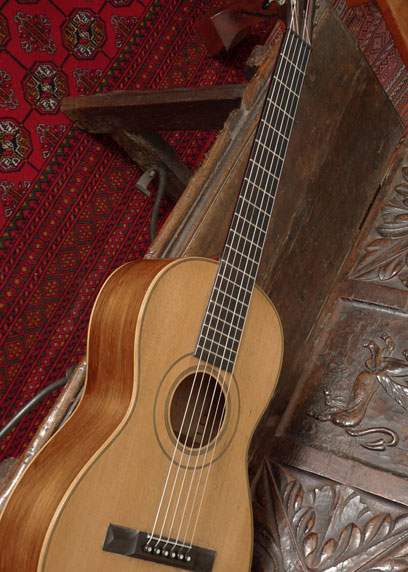 Circa 1860 guitar, style 3 built by well known luthier James Ashborn of Wolcottville, CT, for William Hall & Son music store. Brazilian rosewood back and sides; Adirondack top; maple binding. Rare Brazilian rosewood veneered neck. 100% original, including all original finish, and down to original nut, original bridge (and saddle) that has never been off the guitar. From an article in Vintage Guitar magazine: "Ashborn's design for the guitar was quite innovative for the early 19th century. Instead of making guitars fashioned after the typical parlor-style guitars, he made them in the Spanish style, by taking interior bracing cues from the Spanish while retaining the body of the English guitars. This included a fan brace pattern rather than the more common ladder pattern Ashborn guitars have a very complex dovetail V joint for attaching the head to the neck. The headstock was cut in roughly five steps, using some kind of tracing router, as suggested by the chatter marks on the inside ears of the pegbox. In addition to the complex head design, Ashborn made his own tuning machines in-house. They're made of brass, very much like contemporary machines, with worm gears, cog gears, and rollers. … Ashborn's shop was extremely advanced for its time, having a great deal of know-how and technology. Ashborn understood the need to have the technology as well as the skill, but more importantly he discovered a new way of making high-quality instruments that were affordable. He was able to create a factory environment where workers did what they were good at and, with practice, became very fast and consistent. With a new level of consistency in mass production, he created the path followed by other companies such as Martin, Gibson, and Taylor. Using designs ahead of his time, he was able to bring the sound and change to people who otherwise never would have been able to acquire an instrument of this quality."
Circa 1860 guitar, style 3 built by well known luthier James Ashborn of Wolcottville, CT, for William Hall & Son music store. Brazilian rosewood back and sides; Adirondack top; maple binding. Rare Brazilian rosewood veneered neck. 100% original, including all original finish, and down to original nut, original bridge (and saddle) that has never been off the guitar. From an article in Vintage Guitar magazine: "Ashborn's design for the guitar was quite innovative for the early 19th century. Instead of making guitars fashioned after the typical parlor-style guitars, he made them in the Spanish style, by taking interior bracing cues from the Spanish while retaining the body of the English guitars. This included a fan brace pattern rather than the more common ladder pattern Ashborn guitars have a very complex dovetail V joint for attaching the head to the neck. The headstock was cut in roughly five steps, using some kind of tracing router, as suggested by the chatter marks on the inside ears of the pegbox. In addition to the complex head design, Ashborn made his own tuning machines in-house. They're made of brass, very much like contemporary machines, with worm gears, cog gears, and rollers. … Ashborn's shop was extremely advanced for its time, having a great deal of know-how and technology. Ashborn understood the need to have the technology as well as the skill, but more importantly he discovered a new way of making high-quality instruments that were affordable. He was able to create a factory environment where workers did what they were good at and, with practice, became very fast and consistent. With a new level of consistency in mass production, he created the path followed by other companies such as Martin, Gibson, and Taylor. Using designs ahead of his time, he was able to bring the sound and change to people who otherwise never would have been able to acquire an instrument of this quality." -
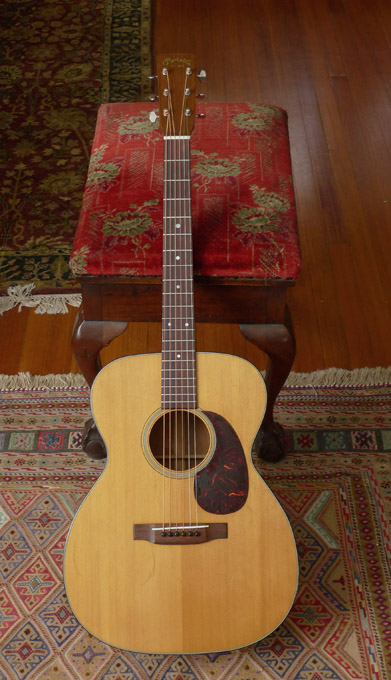 This ’63 000-18 has wonderful tone. It compares favorably to any post-war 000-18 we’ve played.
This ’63 000-18 has wonderful tone. It compares favorably to any post-war 000-18 we’ve played.- All original finish, everywhere
- The guitar is crack-free. Not even a pickguard crack.
- Original Brazilian Rosewood bridge, full height. It has never been off
- original saddle as well
- Original tuners (Grover)
- Original Ivory nut
- Original bridge plate… in perfect condition… in fact, there is not even the enlarged holes you so commonly see from the ball ends of strings working through… it’s a great original small Maple bridge plate…
- Original endpin
- There is some pick wear, and some typical crazing that 60’s Martins all have
- Frets are in good shape. The first several positions show some wear… but not a lot… it does not need new frets.
-
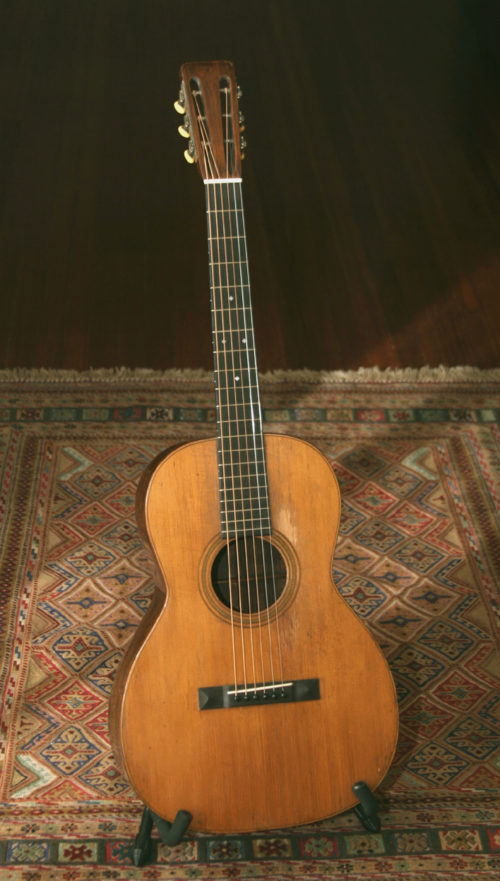 This big 12-fret Brazilian Rosewood pre-war Martin is properly set up for steel strings, with new replacement ebony pyramid bridge meticulously made to original specs, but compensated for steel string, perfect intonation. All braces original and in great shape. Original bridge plate. All original finish everywhere. This guitar has all the tone you'd expect from a pre-war 00 Brazilian Martin. It's had restoration work, all by us, recently, as follows. Hide glue used in all repairs/restoration.
This big 12-fret Brazilian Rosewood pre-war Martin is properly set up for steel strings, with new replacement ebony pyramid bridge meticulously made to original specs, but compensated for steel string, perfect intonation. All braces original and in great shape. Original bridge plate. All original finish everywhere. This guitar has all the tone you'd expect from a pre-war 00 Brazilian Martin. It's had restoration work, all by us, recently, as follows. Hide glue used in all repairs/restoration.- Several cracks in sides, back, and top professionally repaired (5 or 6 cracks overall)
- Small hole drilled in top of headstock many decades ago (to hang the guitar on a wall presumably) has been expertly filled and finished with a piece of Brazilian rosewood veneer, on front, to match the veneer of the headstock.
- Neck set.
- New replacement ebony pyramid bridge meticulously made to original specs, but compensated to steel string intonation. Scratch marks in spruce top, on either side of bridge, filled and finished.
- All new, replacement Bar Frets
- To the thin maple, original bridge plate, we carefully added tiny maple ring/plugs, with hide glue, into the holes, to address bridge pins holes slightly enlarged over the years.
- Older repaired small crack in heel expertly touched up. It's 100% stable. (It appears to be a surface/finish crack.) It's very hard to see even up close, and impossible to photograph.
-
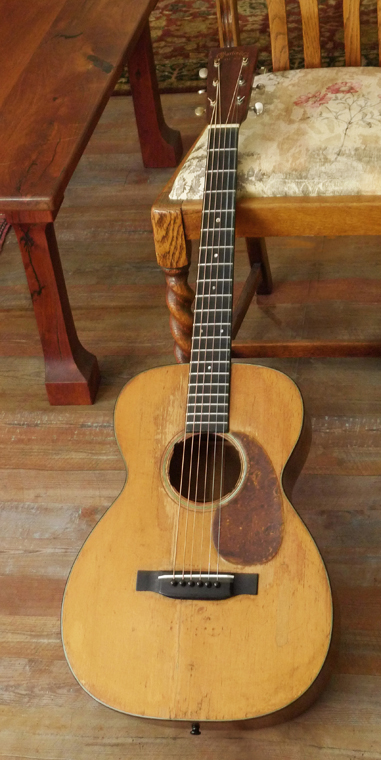 This guitar is probably among the first twenty Martins made in 1939 after the change in nut width on 14-fret models from 1 3/4" to 1 11/16", so yes it is 1 11/16. It has all original finish. Original tuners. Original maple bridge plate. It has multiple repaired cracks on top and sides (no cracks on back). Extensive play wear. New, but perfect, historically correct reproduction Ebony bridge.
This guitar is probably among the first twenty Martins made in 1939 after the change in nut width on 14-fret models from 1 3/4" to 1 11/16", so yes it is 1 11/16. It has all original finish. Original tuners. Original maple bridge plate. It has multiple repaired cracks on top and sides (no cracks on back). Extensive play wear. New, but perfect, historically correct reproduction Ebony bridge. -
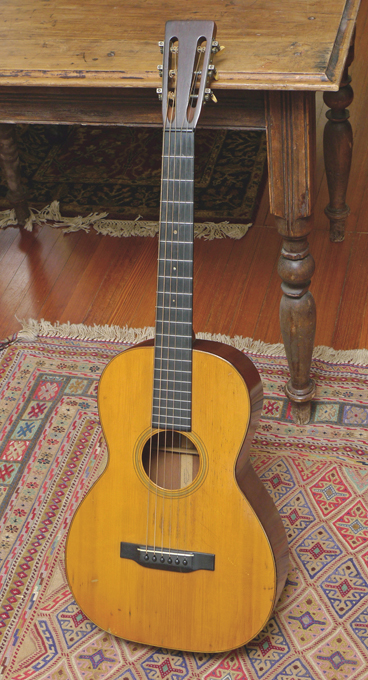 An all-original Martin from the finest era in the company’s history, this 0-18 is unsurpassed for Martin 12-fret Adirondack spruce over Mahogany tone. What can you add about a 1930 Martin, that is 100% original, down to the original bridge pins, and original ivory saddle This example is from the time when Martin had just started using belly bridges, and the ebony belly bridge on this guitar still has its original ivory saddle. And this guitar is 100% crack-free. Period. The instrument features the original bridge (full height), original tuners, original ivory saddle, original nut, and original maple bridge plate (the bridge plate shows almost no wear from ball ends–almost unheard of in a prewar Martin). All original finish– everywhere. Some honest playwear and various minor nicks and dings give the wonderfully aged and naturally honey-hued Adirondack top character. The top shows perfect form, with no bellying behind the bridge, etc. One of the things that makes Martin’s from these year so great-sounding: Martin was still using a thin ebony rod inside the neck, not a metal bar. So the instrument is more free to resonate, from tuners, right down to the bridge. And resonate this one does, with a strong bass especially that puts many many large size guitars to shame. 1-7/8 inch nut. The neck has just been set, by us, retaining the original Bar frets
An all-original Martin from the finest era in the company’s history, this 0-18 is unsurpassed for Martin 12-fret Adirondack spruce over Mahogany tone. What can you add about a 1930 Martin, that is 100% original, down to the original bridge pins, and original ivory saddle This example is from the time when Martin had just started using belly bridges, and the ebony belly bridge on this guitar still has its original ivory saddle. And this guitar is 100% crack-free. Period. The instrument features the original bridge (full height), original tuners, original ivory saddle, original nut, and original maple bridge plate (the bridge plate shows almost no wear from ball ends–almost unheard of in a prewar Martin). All original finish– everywhere. Some honest playwear and various minor nicks and dings give the wonderfully aged and naturally honey-hued Adirondack top character. The top shows perfect form, with no bellying behind the bridge, etc. One of the things that makes Martin’s from these year so great-sounding: Martin was still using a thin ebony rod inside the neck, not a metal bar. So the instrument is more free to resonate, from tuners, right down to the bridge. And resonate this one does, with a strong bass especially that puts many many large size guitars to shame. 1-7/8 inch nut. The neck has just been set, by us, retaining the original Bar frets -
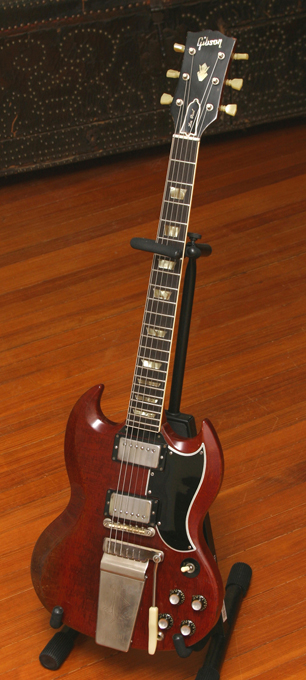 1963 and 1964 were the best years for the legendary early 60's Gibson SG. And 63-64 saw the transition from the Les Paul model to the "Solid Guitar" or SG. Only in 63 and 64 did Gibson use a particularly wide neck on the SG, and that's why players love SG's from these two seminal years. This '64 SG is something of a transition model from the last of the double cutaway Les Paul/SG's to the SG Standard-it carries the Les Paul truss rod cover (original to the guitar), and it features the great lyre vibrola (nickel). This 1964 SG, with all original finish, and original parts (including Patent # humbuckers), is a wonderful instrument with the right amount of honest wear to make it fit like a glove, and play like a dream in your left hand with that wonderful ample neck.
1963 and 1964 were the best years for the legendary early 60's Gibson SG. And 63-64 saw the transition from the Les Paul model to the "Solid Guitar" or SG. Only in 63 and 64 did Gibson use a particularly wide neck on the SG, and that's why players love SG's from these two seminal years. This '64 SG is something of a transition model from the last of the double cutaway Les Paul/SG's to the SG Standard-it carries the Les Paul truss rod cover (original to the guitar), and it features the great lyre vibrola (nickel). This 1964 SG, with all original finish, and original parts (including Patent # humbuckers), is a wonderful instrument with the right amount of honest wear to make it fit like a glove, and play like a dream in your left hand with that wonderful ample neck. -
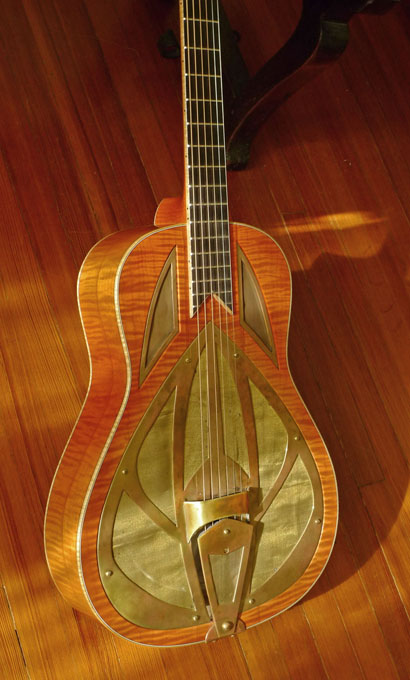 This stunningly beautiful, one-of-a-kind custom built resonator (from 2006, in beautiful crack-free condition and with only light wear) is from Tony Nobles, well-known luthier, and maker of instruments for Joe Walsh, Billy Gibbons and many other artists. The art deco ornamentation compliments an incredibly well built instrument, with meticulous attention to detail. Listen to/watch the video clip where guitar master Redd Volkaert put this instrument through some interesting jazz and blues paces.
This stunningly beautiful, one-of-a-kind custom built resonator (from 2006, in beautiful crack-free condition and with only light wear) is from Tony Nobles, well-known luthier, and maker of instruments for Joe Walsh, Billy Gibbons and many other artists. The art deco ornamentation compliments an incredibly well built instrument, with meticulous attention to detail. Listen to/watch the video clip where guitar master Redd Volkaert put this instrument through some interesting jazz and blues paces.- Spun-aluminum Quartermane biscuit-style cone (single-cone resonator)
- Solid curly maple, back top, and sides, with light tobaccoburst nitrocellulose lacquer finish
- Art deco coverplate, soundholes, and tailpiece of antiqued brass with a metal mesh covering
- Maple binding on body
- Custom torch inlay on headstock
- Curly maple neck
- Waverly tuners
- Scale: 24.4 inches
- Nut width: 1 7/8 inch
- String spacing at nut: 1 18/32
- Bridge spacing: 2 1/8
- Lower Bout: 14 1/2
- Upper bout: 9 1/2
- Body depth at bottom: 3 ¾ inches
- Body depth at neck joint: 3-20/32
-
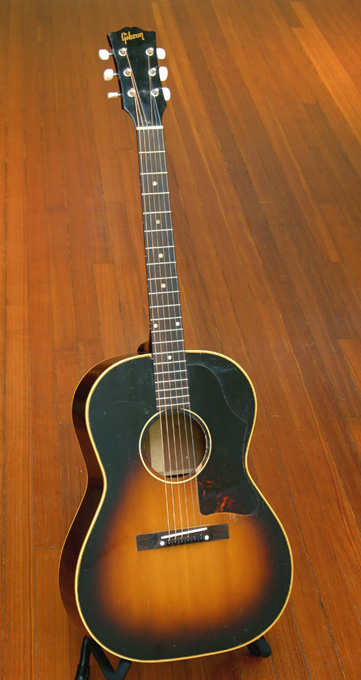 A wonderful, completely crack-free LG-2. The neck was recently set by Mark Erlewine, the frets dressed, and a new saddle installed ... beautifully set up by ME. 1-11/16 inch nut. Mahogany back and sides. Spruce top. Low action, with no buzzing. Nice sustain, and volume.
A wonderful, completely crack-free LG-2. The neck was recently set by Mark Erlewine, the frets dressed, and a new saddle installed ... beautifully set up by ME. 1-11/16 inch nut. Mahogany back and sides. Spruce top. Low action, with no buzzing. Nice sustain, and volume. -
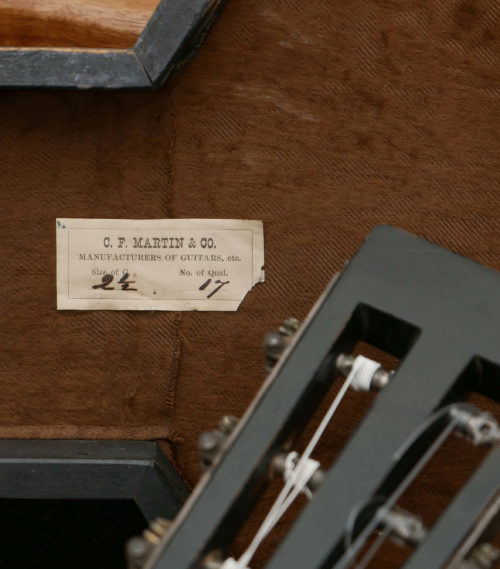 19th century Martin parlor guitar. This lovely sounding Martin 2 1/2-17 features solid Brazilian Rosewood back and sides, Adirondack spruce top, and original Jerome tuners. This particular instrument has a beautiful, lyrical voice. It was made probably circa 1867-1870. There are several clues to establish that: the original coffin case with the guitar has attributes of an earlier case: the small brass handle, and the label inside the case has font and other attributes of late a 1860s case. Also, the particular style of the original Jerome Tuners. Kerfing inside is also indicative of an 1860’s Martin. And, the best clue of all: the 1 ¾ inch nut width. Of course, it’s post-1867, because of the “CF Martin & Co” stamps inside. The top is fan braced, typical of this style. Measurements are: body length 17 7/8", lower bout width 11 5/8", overall length 36 1/2"; scale length 24 ½ inches. 4 inch body depth at end pin; 3 3/8 inch boy depth at neck joint. 1 ¾ inch nut width– may have been a custom order, or just a slightly narrower nut width (from the 1 7/8 more common later) from the factory. 12 fret cedar neck/ebonized, with ice cream cone heel. All original finish, everywhere. A fair-to-low amount of playwear (see photos). Original bar frets in fine condition. Several small hairline cracks in back, repaired. Top and sides also have a couple or repaired cracks. Reproduction ebony bridge– just made by Dick Dubois.. Original bar frets. Original bracing. "C.F. MARTIN &CO/ NEW YORK" hot stamped on back strip inside, and heel block. CF Martin New York stamped on back, by heel joint. Original Jerome tuners, with original buttons– note, one of the sun gears (on the G string tuner) has been replaced, with a different 19th century Martin sun gear (see photo). Historical interest aside (these just-post-civil war Martin guitars are more rare than the 1870’s/1880’s/1890’s examples), this guitar plays wonderfully. It projects glassy brazilian trebles, and clear mids and bass notes. It’s just a joy to play, and it just floats in your hands (due to its very light weight). Action is good, and it plays in tune even on the higher frets. (Note: 19th century Martins can be fitted with: gut strings, classical guitar strings, or sometimes silk and steel/tuned down–depending on the guitar. It’s really a case-by-case basis. One size does not fit all. And different 19th century Martins sound better with different strings. In this case, with this particular guitar, our favorite strings if you want a “classical” style string but more brightness and volume than nylon classical strings: Savarez Alliance composite High Tension strings (note, “high tension” by classical standards– fine for this instrument). This instruments sounds wonderful with those strings. In is original coffin case (and case has all the original hardware, as well as its original cloth interior lining).
19th century Martin parlor guitar. This lovely sounding Martin 2 1/2-17 features solid Brazilian Rosewood back and sides, Adirondack spruce top, and original Jerome tuners. This particular instrument has a beautiful, lyrical voice. It was made probably circa 1867-1870. There are several clues to establish that: the original coffin case with the guitar has attributes of an earlier case: the small brass handle, and the label inside the case has font and other attributes of late a 1860s case. Also, the particular style of the original Jerome Tuners. Kerfing inside is also indicative of an 1860’s Martin. And, the best clue of all: the 1 ¾ inch nut width. Of course, it’s post-1867, because of the “CF Martin & Co” stamps inside. The top is fan braced, typical of this style. Measurements are: body length 17 7/8", lower bout width 11 5/8", overall length 36 1/2"; scale length 24 ½ inches. 4 inch body depth at end pin; 3 3/8 inch boy depth at neck joint. 1 ¾ inch nut width– may have been a custom order, or just a slightly narrower nut width (from the 1 7/8 more common later) from the factory. 12 fret cedar neck/ebonized, with ice cream cone heel. All original finish, everywhere. A fair-to-low amount of playwear (see photos). Original bar frets in fine condition. Several small hairline cracks in back, repaired. Top and sides also have a couple or repaired cracks. Reproduction ebony bridge– just made by Dick Dubois.. Original bar frets. Original bracing. "C.F. MARTIN &CO/ NEW YORK" hot stamped on back strip inside, and heel block. CF Martin New York stamped on back, by heel joint. Original Jerome tuners, with original buttons– note, one of the sun gears (on the G string tuner) has been replaced, with a different 19th century Martin sun gear (see photo). Historical interest aside (these just-post-civil war Martin guitars are more rare than the 1870’s/1880’s/1890’s examples), this guitar plays wonderfully. It projects glassy brazilian trebles, and clear mids and bass notes. It’s just a joy to play, and it just floats in your hands (due to its very light weight). Action is good, and it plays in tune even on the higher frets. (Note: 19th century Martins can be fitted with: gut strings, classical guitar strings, or sometimes silk and steel/tuned down–depending on the guitar. It’s really a case-by-case basis. One size does not fit all. And different 19th century Martins sound better with different strings. In this case, with this particular guitar, our favorite strings if you want a “classical” style string but more brightness and volume than nylon classical strings: Savarez Alliance composite High Tension strings (note, “high tension” by classical standards– fine for this instrument). This instruments sounds wonderful with those strings. In is original coffin case (and case has all the original hardware, as well as its original cloth interior lining).